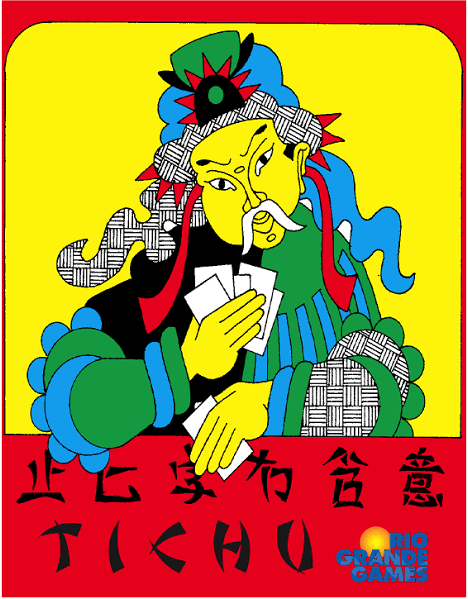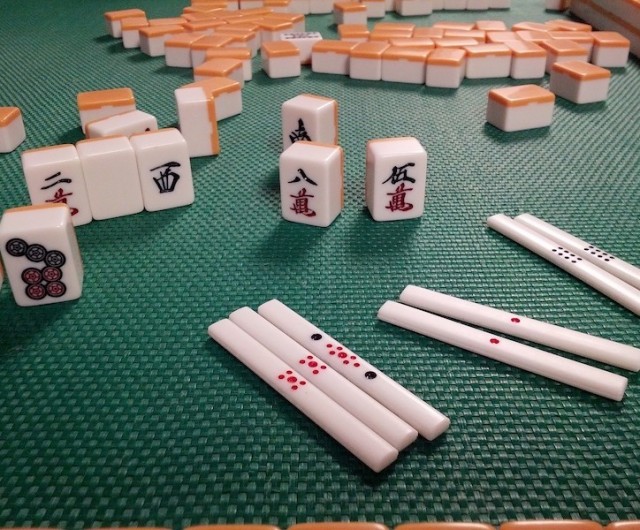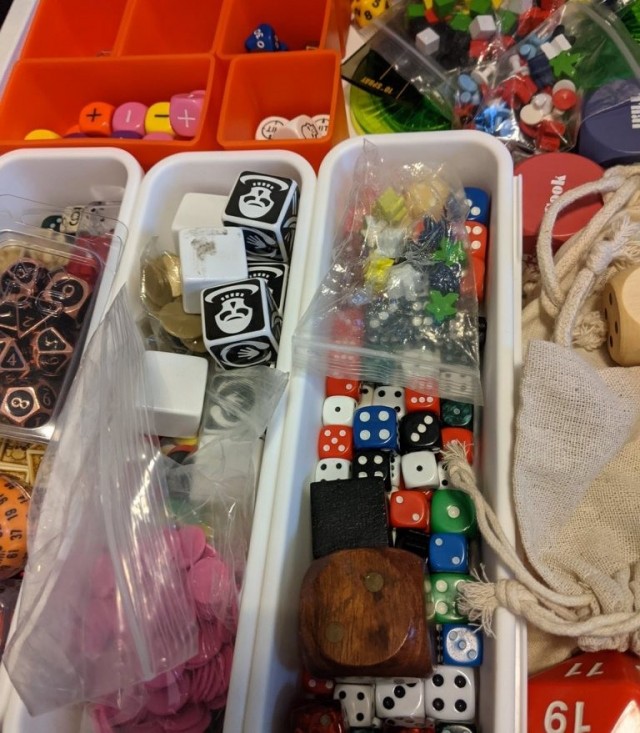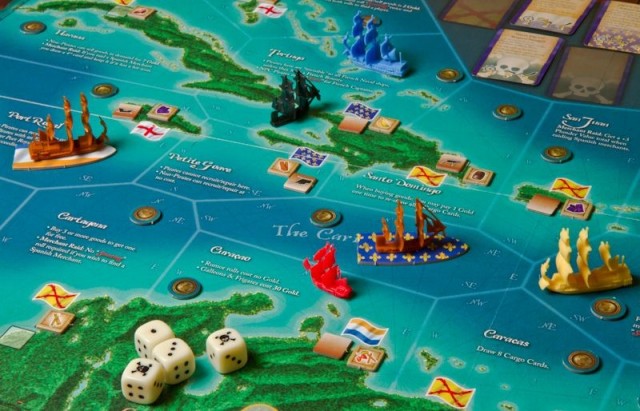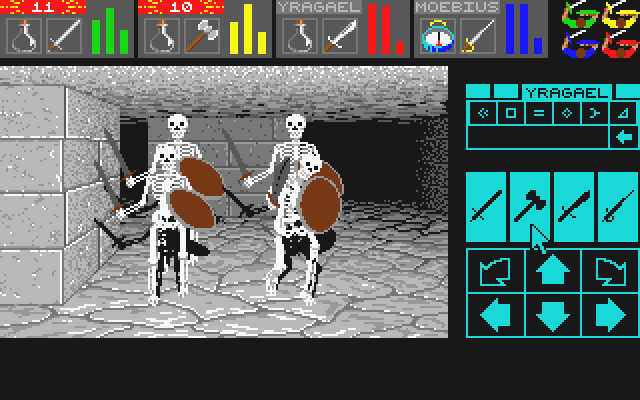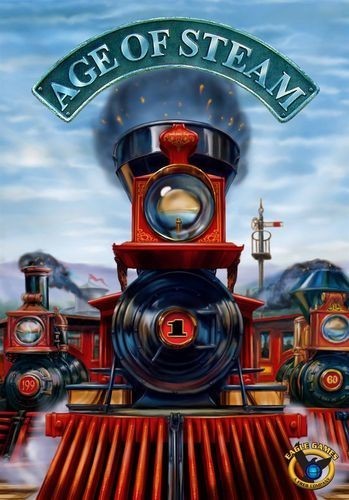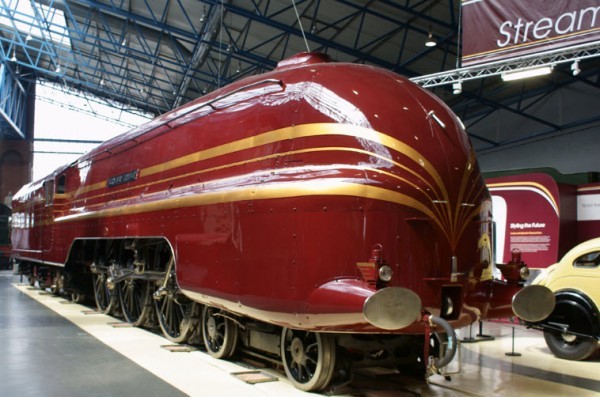A deep dive on the "vanilla" blue guys who are actually more exotic than they first seem.
Just like in Runewars, the Daqan have the misfortune of being assigned the role of "boring humans" in the fantasy world of Terrinoth. Whereas armies of undead or elves are seen as exciting or at least not typical, a force of regular humans is distinctly less so. Even the Uthuk get to be demon-infested humans with weird creatures like Flesh Rippers loping across the battlefield. Whereas in Runewars, the Uthuk top tier (hexagon) unit is a thing called a Chaos Lord, the Daqan top tier unit is... a siege tower. Thankfully, B2E went a little more exotic, but that role as Man from Mundania is also a consequence of the perception of the army's overall design, which is often seen as mostly defensive. Instead of going out and ripping the game from the opponent with claws or infernal fire or treants or something like that, the Daqan seem to be mostly about enduring all of those mystical fireworks and still being present to secure a VP banner for multiple turns. And all of that can be true. You can play a "bunker" style with the Daqan and actually do pretty well with them. But the capability of being a seriously aggressive force is also well within reach of the boring humans, especially given the movement possibilities of Greyhaven Battlemages, Riverwatch Riders, and the Warrior Roc, but also the sheer firepower of units like Yeoman Archers and Ironbound. The versatility of their Lore deck is also front and center, with enough armor and healing to keep the Daqan on the board, but enough surprising punch to wipe out anyone in their way, as well.
Units-

Yeoman Archers- Move: 2; Attack: 2 (Ranged: 1-4); Health: 3
Infantry/Archer/Ranged
Obviously, the best basic use of Archers is to take advantage of their Double Shot ability, since they'll be able to attack twice if they don't move. Of course, if you should move them, thus losing Double Shot, they become somewhat more pedestrian. Being part of a game that gives great weight to positioning, that can be a significant advantage, pending available terrain and starting deployment. In B2E, ranged units tend to fill the role of support units, based largely on the fact that only one result on the dice (Pierce) will count as a hit for them. But if you can establish a position early on, especially one that oversees a VP banner, you can end up doing considerable damage with them, not only with Pierces but also with Morale results, since you'll be forcing your opponent to constantly reposition with a unit that takes up relatively little of your point total; even better if you can sit on a hill that overlaps two sections, giving you the option of your double barrage with twice the number of Command cards. As an Infantry unit, they can also be ordered by Onslaught, but the ultimate Command to play with them, of course, is Darken the Skies, since any that didn't move will be able to attack three times, which can easily lay waste to your opponent's plans, if not their army.
As far as Lore goes, obviously cards like Take Aim will be useful, although it's fair to question the use of 2 Lore for a single attack roll. But Death From Above allows you to continue pouring on the impact of a key Archers unit, since they'll be able to attack twice in a turn, even if they moved. But Enchanted Arrows may be the most devastating available card to this unit, since it encompasses all of them, doubles range, ignores line of sight and makes their damage unavoidable. It's still subject to the dice, but so is every other unit in the game. With that in mind, in the right circumstances, it's fair to consider Rune Blade as an option, since it will give you the repeated opportunity to find those Pierce results that you're so eager to get. And, clearly, taking the scenario, Iron Volley, where you only score VPs with elimination by ranged units, is of high consideration with this unit. If you're emphasizing Archers in your list, playing a scenario like Victory and Valor or The Blind Muir Forest, which give easy access to single or banks of hills, can really enhance their use, since you'll have no concerns about line of sight restrictions.
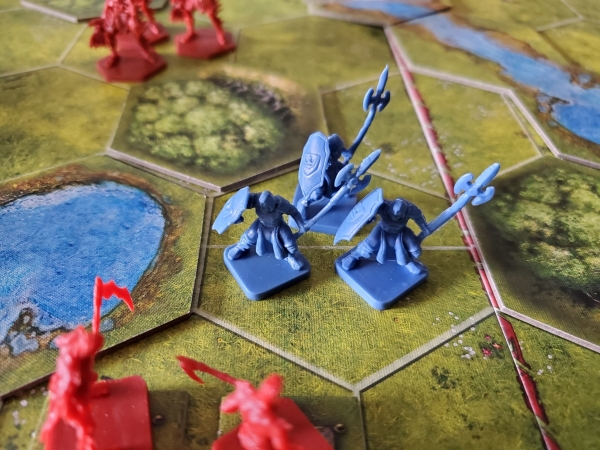
Citadel Guard- Move: 2; Attack: 3; Health: 3
Infantry/Knight/Melee
Like the Archers, Guard are a basic unit, but they're also one of the more versatile units in the game. Again, B2E is a game about positioning, so to have a unit that can take a Strike result and, instead of simply using it for a point of damage, which may be superfluous on a fully healthy enemy or a Legendary with 6 health, use it to cause a retreat is applicable to a huge assortment of situations. Combine that with the ability to Pursue (e.g. move forward and attack again, rather than just move forward) and you can exercise all kinds of interesting maneuvers with what is, again, a "basic" unit. Their versatility is considerable, on top of having the Knight trait, which means that Lore cards you would normally expect only to apply to Lancers can also be used on your multiple units of Guard. Their greater attack value and range of results is superior to Archers but, of course, they have similar movement, which means that scenarios like Ruins of Lore could be a consideration, since you can spend excess Lore to move them. But, obviously, the best choice of scenario with Guard is Mustering the Militia, since a unit of them will cost you only 3 points, instead of the usual 4.
For Lore, Valor and Vengeance immediately stands out, since they can ignore retreats and can counter with a potential 5 dice. But also of note is Lightning Surge, which could be combined with things like Ruins of Lore to make your pedestrian Guard units into something that wrecks (or at least stuns) an entire wing of your opponent's force. But I've also often found that cards like Wall of Steel can be useful in making Guard supremely annoying for those opponents who figured they were simply going to brush aside the common infantry unit, only to be unable to remove them and then be stymied, if not routed, by the counterattack. Like the Archers, using Rune Blade on Guard can be quite a positive thing, especially combined with their Superior Tactics ability, since they'll frequently be able to reposition an enemy unit which then won't be able to counter, if not simply move them from a VP spot and then Pursue to get an attack in, regardless.
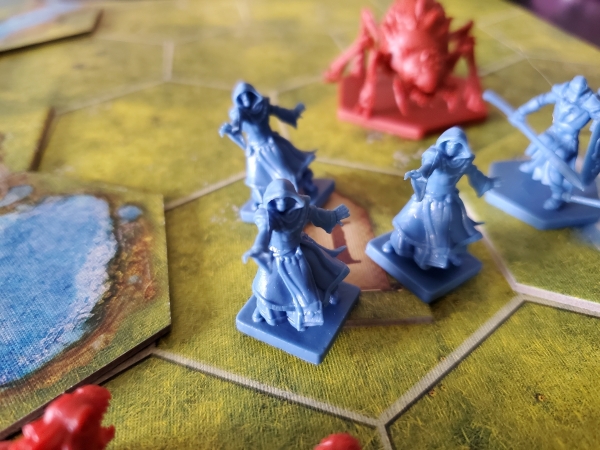
Greyhaven Battlemages- Move: 2; Attack: 3 (Ranged 1-3); Health: 3
Infantry/Caster/Ranged
Going all the way back to the original Runebound and Battlemage Jaes, this is a unit that is deep in the Terrinoth theme. They also continue the Daqan themes of both stalwart defense with their Rune Shield ability, as well as versatility with their Catalyst ability, since Lore results on their attacks give the Daqan player both 1 Lore and a draw from their deck. That makes them an almost literal Ranged support unit, but it also means that fully 2/3 of the die results are significantly positive for them, unlike the 1/3 for Archers, in addition to getting another die with their base attack. They also cost a point more than Archers so you're still paying for it. Proper deployment with your Battlemages is almost more important than your other infantry, since Rune Shield only works on adjacent friendly units. Restricted as they are by their movement rate like most other infantry, you want to be careful about how they advance so that you keep as many potential assists available to you if you're playing defensively. As noted, offensively Battlemages can be significant, since you'll not only be backing up your friends while you're killing the enemy, but also potentially drawing into the better cards in your Lore deck in the process. Versatility, again, is a key word with the Daqan in general and the Battlemages in particular.
Obviously, Healing Hands is absolutely the card you want to draw with Battlemages, since you'll be able to either recover health or gain shields with two different units at double the normal range of Rune Shield for just 3 Lore. You also get to do this during the Move step, so before or after you move your mages to a better position. It's a ridiculously good card. Blinding Light is also a good card, but a bit more situational, since you'll want to exercise it in the midst of a grouping of enemy units and it also costs 8 Lore, which is a hefty price for something that neither moves nor eliminates the enemy. However, remember that Stuns deny counters, as well, so freezing some dangerous opponents in place to be beat upon by your Citadel Guard at no risk isn't the worst idea. Also, keeping Intercede handy while you have shielded units in play can be fairly significant if your opponent was building up to something big. The shielded unit not only excludes a die result, but will also ignore a point of any ensuing damage, regardless. Once again, I will beat the drum for Rune Blade with Battlemages, as well, since it's more likely that you'll accumulate positive results on the dice than the two faces that you don't want (Strikes and Cleaves.) That aforementioned need for proper positioning makes scenarios like The Blind Muir Forest, where they can begin in the trees on either side of the board, advantageous. The VP goal of Behind the Lines also basically demands their presence.

Riverwatch Riders- Move: 4; Attack: 2: Health: 3
Cavalry/Melee
One of the best units for the Daqan for that versatility theme, Riders are often absurdly capable. With a great movement rate, no fear of counters, and the ability to enhance the offense of every other unit in your list, Riders can be a constant threat to your opponent, especially if they can take advantage of Crystal Spires (+1 die to attack if they begin their movement in a Spire space), which they often can because of their great movement. They're one of the ultimate examples of coordinated unit action that function well with almost every Command card out there, since they can obviously take advantage of Echelons, Patrols, and Attacks, but can also enhance things like Line Advance, as their movement will often make them capable of getting to an adjacent space to an enemy and allowing Flanking to come into play. The vast majority of wargames (and warfare, for that matter) emphasize movement and the ability to get there the fastest with the mostest. Riders are a perfect example of that principle in action. The fact that their attack value is less than most melee units at 2 dice isn't as important as long as you're not relying on them to secure an objective on their own. Like the Battlemages, they're best when working in concert with other units. Of course, since Flanking works with any attack, it's not unusual for them to enhance the multiple volleys of Yeoman Archers, which works even better if you can get your Riders behind the enemy, so that Morale rolls also contribute even more damage to the target unit. Each unit of Riders does cost 6 points, so they're not cheap but, in my experience, they're worth every point and I always try to play with 1 or 2 in every game with the Daqan.
Of course, Overrun is the perfect Lore card for Riders, given that you can potentially do 2 points of damage to a unit in the Move step before even considering a regular attack and/or Flanking bonuses for others. Interestingly, Defend the Realm isn't as good as with other units, since Riders will so often be in the opponent's half of the board that I've found that the VP gain is actually less likely. Behind the Lines is a great scenario for Riders, since it emphasizes movement into the enemy zone to take the Daqan banner and also requires Spires for the secondary VP bonus. The Ruins of Lore can also be positive, since you can take even greater advantage of the Riders' movement by potentially giving them a movement of 5 for the turn. In that respect, Korrina's Tears is also an example of playing up that advantage, since you'll be able to ignore the restrictions of water spaces as long as you have the Lore to spend.
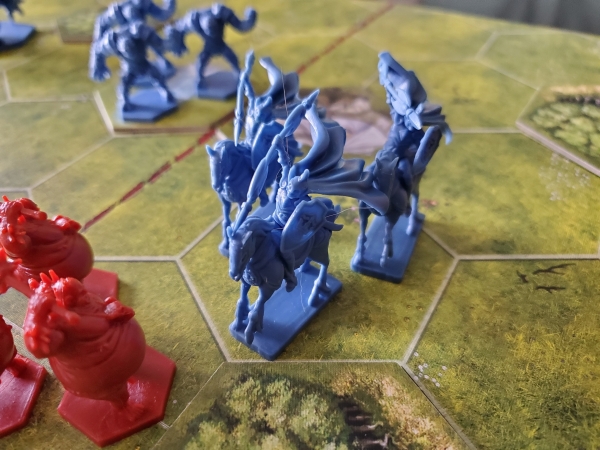
Citadel Lancers- Move: 3; Attack: 3; Health: 3
Cavalry/Knight/Melee
Lancers are thematically mounted Citadel Guard, as both the name and movement rate suggest. They're a bit more front-loaded than the Guard, though, since they won't be able to perform as many tricks as their footmen brethren, but can routinely wipe out enemy units with a single attack, since half of the die results (Strike, Cleave, Heroic) will result in damage if they weren't adjacent before the attack. If the target was supported, as you'd routinely like them to be in the front lines of your formation, that goes up to 2/3 of results on a move-attack. They're the prototypical medieval knights of history; smashing everything in their path and continuing to move so that someone can't pull them from their horses. Setting up attacks is going to be key to proper play with the Lancers. Like Riders, they're one of the units that belies the "defensive" assumption about the Daqan. Far more hammer than anvil, as it were. Also like Riders, they're 6 points/unit and, in this case, you're paying that price more for potential reasons than for practical ones. If you do get a move-attack opportunity and do get a good roll, that potential for instant removal and Advance is certainly there, which also means that you won't be countered on that charge forward. The contrast to Riders is that even in their advanced position, they inherently can't be countered. But Lancers are about direct removal, not coordinating with other units for potential removal. Lancers will also only ever Advance, not Pursue like Guard, so it's really a different mindset than what the base game units set you up for vis-a-vis the Daqan, which is commendable, since the Hernfar Guardians expansion offers not just "more", but "more and different", which is what all expansions should be.
Like the Riders, Overrun can be great with the Lancers, albeit slightly less so given their lesser movement. Wall of Steel is actually a great way to preserve your Lancers in a forward position, since the enemy will naturally converge on them and try to prevent any further one-shots from them. Portal also has great use in setting up precision attacks by the Lancers, especially when targeting the opponent's VP banner spaces. And, of course, Lightning Surge is even more useful for Lancers than it is for Guard, given the advanced positioning of the former and the potential to deal out even more stuns. Both Victory and Valor, which emphasizes forward deployment, and The Blind Muir Forest, which emphasizes concentrating in the middle section, are solid scenario picks for an army that includes Lancers. As with Riders, Behind the Lines is also a good choice if you feel that you'll be able to protect your Lancers as they take the Daqan banner space. I've also had good luck with Damming the Muir River, given the unusual deployment space in the fourth row of the center section (most scenarios stop at the third row) and the ability to not stop at a ford on the water spaces on the right side. If you concentrate your Lancers on that side and get a Patrol or Attack, it's a good way to execute what USC football used to refer to as "Student Body Right" (i.e. overloading everything on that side and then tearing through your opponent's back lines.)
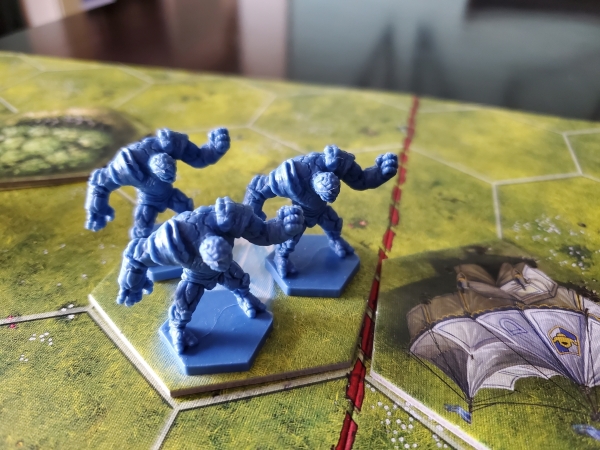
Rune Golems- Move: 2; Attack: 3; Health: 3
Elite/Melee
Wait, did someone say "defensive", "durable", Daqan? (It's DDD-rated!) Golems are perhaps the most obvious thematic unit for the Daqan which differs from "vanilla humans." Up to now, almost everything we've talked about could've been drawn from a standard historical wargame (Yes, not Battlemages, aside from their "regular dudes with a ranged attack" aspect.) But these are magical automatons, which brings a whole other dimension to the faction. They're also one of the best units in the game for taking a space and then just sitting on it, extracting VPs, and resisting most attempts to remove them. That's why they're Immovable, yo. But Stunning Blow also does great work, since it prevents attacks and counters from anything that's suffering under it and for which the opponent isn't willing (or able) to pay 2 Lore to remove the effect. They're also the direct subject of a couple scenarios for the Daqan, almost like the designers were trying to compel people to try the stone guys, since they don't do anything flashy or involving a great sweep of movement. Instead, they're the linchpin on which the rest of your force can often pivot. Like the mounted units, they're 6 points/unit, so they will take some list space, but they're also usually reliable, especially if you have a Battlemage unit hovering nearby with Healing Hands to contribute.
Obviously, the ultimate Lore card for the Golems is Crushing Blow, since it not only lets you order them irrespective of Command card, but also gives them a ridiculous boost to their attack for the turn. Additionally, Stalwart Defenders can make them even more frustrating to your opponent's efforts to remove them; piling on in the same way that you'd use movement Lore to enhance your Riders. Wall of Steel is also a good choice in that respect, since you can happily pick a half of dice that includes a Morale result that you'll simply ignore. In that respect, Intercede is also useful. It's typically a card that you want to use for one of your less expensive and, therefore, more expendable units, rather than an Elite one. But since you already have an advantage against Morale results, you're often safer in denying a damage result so that your Golems have a higher chance of simply resisting whatever the opponent is trying to do. As noted, instead of citing a unit type (infantry, caster, etc.), both Damming the Muir River and Barrow Mounds of the Gatesmen specifically name Rune Golems as the key to the additional VP goal and both maps emphasize the right side of the board to do so. Barrow Mounds also adds a ranged attack to any Golem unit that fits the scenario theme (e.g. standing on a hill hex), which practically demands that you take them for a game with that setup. But most of the scenarios that involve holding a position are well served by the stone guys.
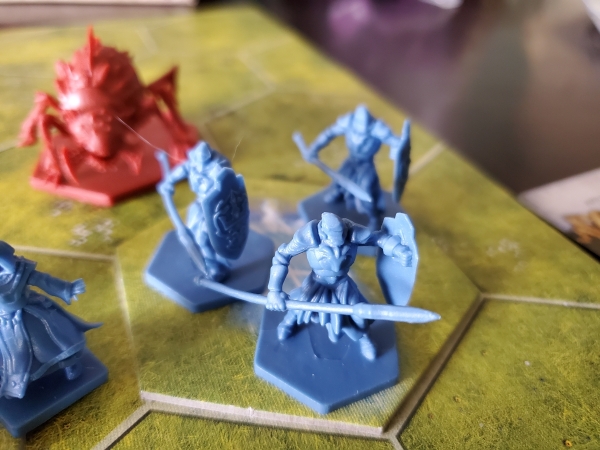
Ironbound- Move: 1; Attack: 4; Health: 3
Elite/Melee
The initial reaction by many to the stats of Ironbound was the same as their reaction to my favorite Uthuk unit, Obscenes: "One movement?!" Don't let it fool you. Ironbound can be amazing, even if you think that their ability to apply their impressive Attack stat will be limited by the opportunity to deliver it. You simply have to keep the Lore available to use them. Automaton means that, regardless of scenario or available Lore card or, especially, Command card, you can spend 1 Lore to order them and double their movement rate in order to close with an enemy in any section of the map and dish out ridiculous damage plus ignore part of what may return on the counter. They're brilliant and a serious threat to anything in the vicinity. Thematically, they do trend toward more of the same (instead of walking stone guys, these are walking metal guys) but they're far more of an offensive force than the Golems typically are. Instead of being something that's noted as difficult to remove, they're much more of a problem that continues to roll forward and threaten your opponent's plans; more of a bulldozer than a dam. You just have to be willing to squirrel aside that 1 Lore, every turn, to make them a constant threat. Almost every game I've played with them, it's paid off.
Obviously, Portal can be enormous with them, since it gives you the opportunity to have that constant threat in your opponent's backfield for however long they continue in the game. Likewise, Valor and Vengeance only highlights that threat and the disruption they can cause to your opponent's plans. A properly-timed Intercede, listing Strike as the result to be ignored, can also be huge. Obviously, Machinations of War is just a way to make them an absurd thorn for your opponent, since you get a chance to destroy their intended plan before they can even begin to execute it. Unlike the Golems, Ironbound don't have any specifically targeted scenarios, but that's understandable, since their Automaton ability makes them inherently useful in all of them. That ability makes Crossing the River of Sleep stand out a bit more, since you'll end up with a larger pile of Lore for any points not spent at setup. The Ruins of Lore allows you to double up on the Automaton rule, albeit with the move bonuses separated across your turn (Order step and Lore step.) But Iron Volley potentially grants them Riders-level movement, which can be terrifying to the opponent, even if it's only a 1 in 3 chance and requires Spires. Starting some Ironbound in a Spire space could mean that they're a Move 4, Attack 5 unit that turn...
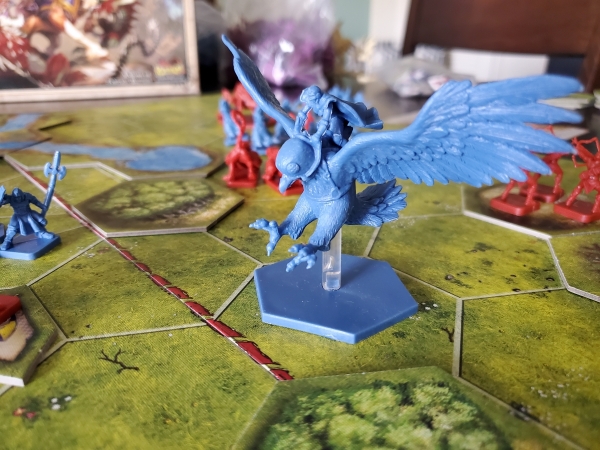
Roc Warrior- Move: 3; Attack: 4; Health: 4
Legend/Melee
Flat out, the Roc is among the best Legendary units in the game, if not the best unit, period. Even with the lowest health among Legendaries, the insane versatility that its Mobility ability (plus the rhyming) provides means that there's almost no situation (and certainly no scenario) in which it won't provide an advantage. Furthermore, with the defensive capabilities of the Daqan Lore deck and the presence of units like Battlemages, even the supposed weakness of its relative low health isn't that much of a concern. On top of that, it's a Flying unit, which means that melee attacks will be more limited in the first place, but Mobility also allows it to remove itself from danger, as long as it was one of the ordered units that turn. It lacks the brute force that units like the Chaos Lord and Barrow Wyrm can bring, but that's the kind of activity better left to Ironbound and Lancers, anyway. If there's a default unit for any game I play with the Daqan, the Roc Warrior is basically it. Few other units in the game can match its combination of versatility and power, especially because it ignores all terrain like Flying units do, but also isn't restricted by it, so it can take shelter in building hexes.
Obviously, Take to the Skies is the key card that you want to have available, since it not only can drop an enemy unit in a far less advantageous position (say, off a VP spot and next to an Ironbound unit), but the converse can be done for your own units (say, away from a group of Reanimates and into a VP-scoring building hex.) That's a repositioning of two different units that can completely alter the face of battle (Keegan!) that turn. Also, in terms of protecting your precious asset, Battle Cry can be hugely useful on your opponent's turn, but can also be important on your turn, once you've moved away from a fight but want to push the opponent away from their intended approach. The mobility of the Roc upgrades that card from a simple escape tool to a tactical implementation. But Death from Above is almost as devastating, since it allows the Roc to attack twice in one turn. Again, there are no scenarios in which the Roc Warrior doesn't excel, but some notable standouts are things like Mustering the Militia, where the close location of the three buildings on the right side means that the Roc can easily do hit-and-run attacks on nearby opponents and retreat to a building to maintain the VP goal. Similarly, Barrow Mounds of the Gatesmen provides for easy coordination between the Roc and multiple Rune Golem units firing from the hilltops.
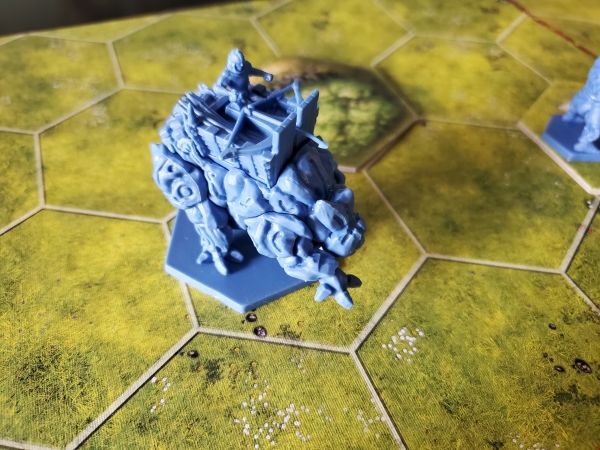
Siege Golem- Move: 1; Attack: 4 (Ranged 2-6); Health: 6
Legend/Ranged
In complete contrast, the Siege Golem is a unit with which I've never had consistent success. Unlike units like Ironbound or Obscenes, which have compensatory abilities for their low movement, the Siege Golem not only lacks those, but can't move at all in the Move step if you want to be able to attack with it. It's almost the definition of the "vanilla" perspective on the Daqan in that it's slow, sturdy, and doesn't really do much that's interesting or flashy. The ideal situation is to get it into a building hex or on a VP space and let it camp out there, firing at enemies across the map. The upside is that units won't interfere with line of sight. The downside is that terrain still will. And, of course, in dealing with a Ranged unit, we're still talking about a 1 in 6 chance of actually doing damage to your intended target, albeit with an equal chance of doing damage to enemies next to that intended target. If that makes it sound like the Golem has bad aim on top of everything else, you're not alone. A further downside is that its attack has a minimum range of 2, which means it can't hit adjacent units, so you'll often require units of Guard or Archers around your Golem to fend off Blood Harvesters or Reanimates trying to beat it down, even though it can shoot over them to better targets. Granted, putting the Golem on a Spire gives it an even more impressive attack and coordinating that with Riders means it could be launching 6-dice volleys whenever you're able to order it. But that's a lot of effort for a unit that doesn't do much else.
Obviously, more than any other, the Golem stands out for Rune Blade use, since you'll occasionally be able to take down 1 or even 2 units with one salvo. In that respect, Take Aim may be even better (5 dice, re-rollable.) Battle Cry has solid application here, as well, since it will push enemies back into the Golem's range or keep it from being beat on by them. Intercede can also find use with the Golem if you need to protect a more fragile unit. It can't be ignored that it can not only absorb 6 wounds but also ignores at least one Morale result. But Spotter is clearly the best Lore card with the Golem, since it obviates one of its main drawbacks (terrain) and upgrades its attack to the point where you should be able to reliably eliminate a unit. As for scenarios, one can argue for Korrina's Tears, since it's possible to build up quite the firebase on the right side and gain 1-4 VPs/turn while doing so. Sheltered Barrage also provides some flexibility for location, with the hills dispersed into all three sections and Spires costing only 1 point each. And, of course, Ruins of Lore is useful for getting the Golem into position, although you have to wait until the end of your turn to do so. In short, it's not horrible and there are possibilities for it, but at 8 points, I'm not sure it lives up to the price tag.
Lore deck 1: Assault, Battle Cry, Crushing Blow, Death from Above, Defend the Realm x2, Enchanted Arrows, Overrun, Plunder x2, Portal, Rune Blade x2, Runic Barrier, Stalwart Defenders, Take Aim, Take to the Skies, Valor and Vengeance, Wall of Steel x2. Total cost: 67. Average cost: 3.3.
Lore deck 2: Blinding Light, Defend the Realm x2, Healing Hands x2, Intercede, Lightning Surge x2, Machinations of War, Overrun, Plunder x2, Portal, Rally Cry, Runic Assault, Spotter, Stalwart Defenders, Valor and Vengeance, Wall of Steel x2. Total cost: 71. Average cost: 3.5.

In contrast to that "vanilla" perception, the Daqan are obviously meant to have a slight magic edge over their opponents, as both of their Lore decks are the cheapest in the game, with each of the Uthuk and Waiqar decks totaling 72+. Given the Battlemages' Catalyst ability (gain Lore and a card on Lore results on the dice), that means that they should generally have more access to the spells and effects that they want to cast at any given moment; pending variability of both draw and game conditions, of course. The presence of cards like Plunder also adds to that capability. The Daqan also have access to a couple impressive "massive" cards (cost 7+ with significant effects), with Assault, Runic Assault, and Blinding Light. But the latter is tied to one type of unit (Caster) and can be dependent on the enemy clustering in one location to genuinely be worth its cost. Assault, though, is board-wide and adds at least one hit and one Morale result to every attack (Melee and Ranged.) But the true winner in this respect may be Runic Assault, which is 1 Lore cheaper than its non-runic cousin and not only adds two more units to those being ordered (meaning two more attacks, as well) but also allows for an additional Lore card to be played in the same turn. You might not have much Lore left after paying for Runic Assault, but if you do, that turn can easily become game-turning. Defend the Realm, however, stays within that "defensive" theming, since it grants VP for eliminating enemies in your half of the board. Runic Barrier is also the only counterspell card in the game that doesn't permit a choice by the opponent to allow the Lore card to take effect.
So that's the Daqan Lords. I hope I've elaborated enough upon the idea that they're very far from "vanilla", even if they aren't quite as visceral as the Uthuk Y'llan or as arcane as the hordes of Waiqar. There's a great deal of tactical application and coordination that one can engage in with this faction and it's a process of discovery that I think is one of the game's greatest strengths. Next time, we turn to the blood-crazed and demon-infested red guys...
 Games
Games How to resolve AdBlock issue?
How to resolve AdBlock issue? 


